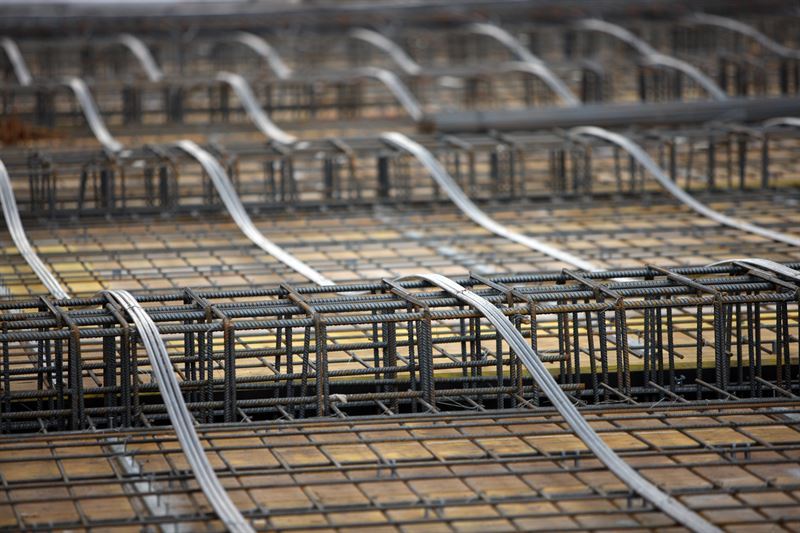Elanikud soovitavad: Päevalille 17 sai erakordselt kõrge hinnangu
- EE Articles
- Uudised
- 10.09.2020
- AS YIT Eesti
Pingbetoonehitus on ehitusvaldkonnas kitsas nišš, aga tavaline sektor
Pingbetoontarindeid kasutatakse üle maailma laialdaselt, aga Soomes on vaid mõni ettevõte, mis neid tellimusi ette võtab. YIT pingbetooni üksus arendab isegi oma tööriistu.

Betooni pingestamine on lühidalt seletatuna tarindite tugevdamine. Põhimõte on sama, mis siis, kui võtta lõõtspillina käte vahele hunnik raamatuid: neid tuleb suruda kahe käega, et need põrandale ei kukuks. Mida kõvemini surud, seda rohkem võib raamatute peale asetada lisakaalu.
Pingbetooni puhul surutakse raamatute asemel kokku betoontarindit. Raketise sisse pannakse enne betooni valamist painduvaid terastrosse kaare kujuliselt, mille kuju ehituskonstruktor on valmis arvutanud. Umbes nädala pärast, kui betoon on kuivanud, pingutatakse trosse hüdraulilise tungraua abil, misjärel saab tarindit kavandatud viisil koormata. Trossi üks ots on ankruga tugevasti kinni kiilutud, et see tarindi küljest lahti ei libiseks, ja teisest otsast pingutatakse. Kui trossile on rakendatud soovitud jõudu, lukustatakse trossid kiiluga paigale. See kergitab tarindit veidi kaarjalt ülespoole, mõnikord on seda näha isegi palja silmaga, aga tegemist on alati maksimaalselt mõne sentimeetriga. Kui siis tarind saab kasutuseks ettenähtud koormuse, sirgeneb see tasapinnaliseks.
Pingbetoontarindeid kasutatakse kõikjal, muu hulgas parkimismajades, sildades, erinevates hoonetes äriruumidest kortermajadeni, rööbasteede ehitamisel, tuuleenergiarajatistes ja hüdroelektrijaamades, tuumaelektrijaamades, veetornides, veepuhastusjaamades, sadamates ja rafineerimistehastes. Meid ümbritsevas ehitatud keskkonnas kohtab selliseid tarindeid seega igal pool.
Ohutus on pingbetooni A ja O
„Pingbetoontarindeid kasutatakse laialdaselt üle maailma, aga Soomes on vaid mõni ettevõte, mis neid tellimusi täidab. Me oleme seega ehitusvaldkonnas kitsas sektor, aga selle tavaline osa. Peamiselt töötame majaehituses, aga teeme ka sillatarindeid ning erinevaid maa- ja kaljuankruid näiteks tuuleturbiinidele,“ räägib YIT pingbetoontööde üksuse juht Mikko Toivonen.
Toivoneni meeskond arendab ka oma tööriistu, enamasti tööohutusest juhindudes, sest ohutus on ehitusvaldkonnas alati esikohal. Spetsiifilistel töödel, nagu on pingbetoontööd, pööratakse sellele erilist tähelepanu. Üksuse töötajad peavad oma kohuseks, et nendega koos töötavad inimesed saaksid olla tööl väljaspool ohtu ja teaksid riske, mis on tööga seotud.
„Et selles töös on hüdrauliliste tungraudadega tegutsedes tegemist suurte jõududega, kordame tööohutusmantrat igas faasis, et meiega koos ehitusobjektil viibijad oleksid selle omandanud. Kuigi meie jaoks on see rutiin, ei ole see seda tingimata teiste objektil töötavate inimeste jaoks,“ ütleb Toivonen.
Tööohutust võib võrrelda lennuliiklusega. Kõigis faasides läbirääkimistest tööni võetakse läbi tööohutus ja sellega seotud plaanid. Kõiki tööriistu kontrollitakse enne iga tööd ja kui betooni pingestatakse, võib ohutusala olla mitme meetri laiune.
„Tungraudade taga on 15-meetrine ala, kus ei tohi tööde ajal viibida, et sellises ebatõenäolises olukorras, et tross katkeb, ei seisaks selle löögialas kedagi. Hüdraulikavoolikutes on väga kõrge rõhk, nii et lahti tulles võivad need lähiümbruses kahju tekitada. Tööriistu kontrollitakse üha uuesti ja uuesti, et kahju vältida.“
Kannatlikkus, organiseerimisvõime ja prioriseerimisoskus
Pingbetoontööde õppimine võtab kaua aega, keskmiselt 2,5 aastat. Töid ei õpita koolis, vaid objektidel kogenumatelt tegijatelt.
Üksuses töötamine nõuab kannatlikkust, organiseerimisvõimet ja oskust prioriseerida oma tööülesandeid iseseisvalt.
Üksus pakub lisaks tööle oma kontserni objektidel teenuseid ka teistele ehitusettevõtetele. Lisaks sellele tegeleb Toivonen ka projekti kavandamise ja projekteerimise juhtimisega, mille kõrval koolitab ta erakordselt nõudlike betoontarindite kursusel töödejuhatajaid ning peab tarindite konstruktoritele loenguid objekti tööprotsessi arvesse võtmisest pingbetoontarindite konstrueerimisel.
„Pean tähtsaks informatsiooni jagamist, mida omale on aastate jooksul kogunenud. Käin hea meelega rääkimas meie üksuse teenustest. Minu töökohustuste hulka kuulub aitamine üle segmendipiiride pingbetoontarindite konstrueerimisprotsessi käivitamisel ning tarindilahenduste optimeerimisel. Hea meelega käin ka rääkimas pingbetoonalternatiivi võimalustest projekti jaoks karkassilahendust valides. Võtke julgelt ühendust!“
Lisainfo:
Mikko Toivonen, head of the post-tension work unit , YIT Corporation, tel. +358 (0) 50 564 6997, mikko.toivonen@yit.fi
Pirita Tiusanen, Communications Manager, YIT Corporation, tel. +358 (0)44 240 9822, pirita.tiusanen@yit.fi
YIT on suurim Soome ja oluline Põhja-Euroopa ehitusettevõte. Me arendame ja ehitame kortereid, äripindu ja terveid piirkondi. Lisaks sellele oleme nõudliku infrastruktuuri rajajad ja teekatete ehitamise spetsialistid. Koos klientidega loovad meie ligi 8 000 professionaali senisest funktsionaalsemaid, atraktiivsemaid ja jätkusuutlikumaid linnu ja elukeskkondi. Tegutseme 10 riigis: Soomes, Venemaal, Rootsis, Norras, Balti riikides, Tšehhis, Slovakkias ja Poolas. Aastal 2019 oli meie käive ligikaudu 3,4 miljardit eurot. YIT Oy aktsia on noteeritud Helsingi Nasdaq OMX börsil. www.yitgroup.com



